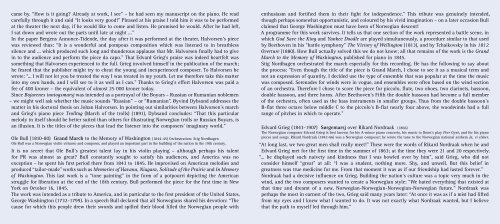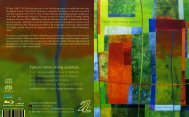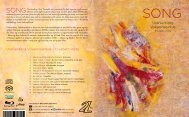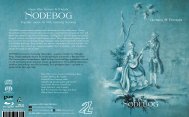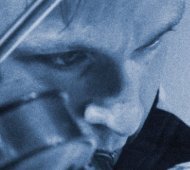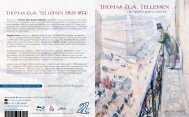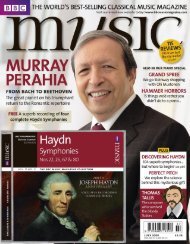You also want an ePaper? Increase the reach of your titles
YUMPU automatically turns print PDFs into web optimized ePapers that Google loves.
came by. “How is it going? Already at work, I see” – he had seen my manuscript on the piano. He read<br />
carefully through it and said “It looks very good!” Pleased at his praise I told him it was to be performed<br />
at the theater the next day, if he would like to come and listen. He promised he would. After he had left,<br />
I sat down and wrote out the parts until late at night ...”<br />
In the paper Bergens Annonce-Tidende, the day after it was performed at the theater, Halvorsen’s piece<br />
was reviewed thus: “It is a wonderful and pompous composition which was listened to in breathless<br />
silence and ... which produced such long and thunderous applause that Mr. Halvorsen finally had to give<br />
in to the audience and perform the piece da capo.” That Edvard Grieg’s praise was indeed heartfelt was<br />
something that Halvorsen experienced to the full. Grieg involved himself in the publication of the march;<br />
he feared that the publisher might try to cheat the young and inexperienced composer. To Halvorsen he<br />
wrote: “... I will not let you be treated the way I was treated in my youth. Let me therefore take this matter<br />
into my own hands, and I will see to it as well as I can.” Thanks to Grieg’s effort Halvorsen was paid a<br />
fee of 400 kroner – the equivalent of almost 25 000 kroner today.<br />
Since Bojarenes inntogsmarsj was intended as a portrayal of the Boyars – Russian or Rumanian noblemen<br />
– we might well ask whether the music sounds “Russian” – or “Rumanian”. Øyvind Dybsand addresses the<br />
matter in his doctoral thesis on Johan Halvorsen. In pointing out similarities between Halvorsen’s march<br />
and Grieg’s piano piece Trolltog (March of the trolls) (1891), Dybsand concludes: “That this particular<br />
melody in itself should be better suited than others for illustrating Norwegian trolls or Russian Boyars, is<br />
an illusion. It is the titles of the pieces that lead the listener into the composers’ imaginary world.”<br />
Ole Bull (1810-80) Grand March to the Memory of Washington (1844-45) Orchestration: Stig Nordhagen<br />
Ole Bull was a Norwegian violin virtuoso and composer, and played an important part in the building of the nation in the 19th century.<br />
It is no secret that Ole Bull’s greatest talent lay in his violin playing – although perhaps his talent<br />
for PR was almost as great? Bull constantly sought to satisfy his audiences, and America was no<br />
exception – he spent his first period there from 1843 to 1845. He improvised on American melodies and<br />
produced “tailor-made” works such as Memories of Havana, Niagara, Solitude of the Prairie and In Memory<br />
of Washington. This last work is a “tone painting” in the form of a potpourri depicting the American<br />
struggle for liberation at the end of the 18th century. Bull performed the piece for the first time in New<br />
York on October 16, 1845.<br />
The work was intended as a tribute to America, and in particular to the first president of the United States,<br />
George Washington (1732-1799). In a speech Bull declared that all Norwegians shared his devotion: “The<br />
cause for which this people drew their swords and spilled their blood filled the Norwegian people with<br />
enthusiasm and fortified them in their fight for independence.” This tribute was genuinely intended,<br />
though perhaps somewhat opportunistic, and coloured by his vivid imagination – on a later occasion Bull<br />
claimed that George Washington must have been of Norwegian descent!<br />
A programme for this work survives. It tells us that one section of the work represented a battle scene, in<br />
which God Save the King and Yankee Doodle are played simultaneously, a procedure similar to that used<br />
by Beethoven in his “battle symphony” The Victory of Wellington (1813), and by Tchaikovsky in his 1812<br />
Overture (1880). How Bull actually solved this we do not know; all that remains of the work is the Grand<br />
March to the Memory of Washington, published for piano in 1845.<br />
Stig Nordhagen orchestrated the march especially for this recording. He has the following to say about<br />
the process: “Even though the title of the piece is Grand March, I chose to see it as a musical term and<br />
not an expression of quantity. I decided use the type of ensemble that was popular at the time the music<br />
was composed. Serenades for winds were in vogue, and ensembles were often based on the wind section<br />
of an orchestra. Therefore I chose to score the piece for piccolo, flute, two oboes, two clarinets, bassoon,<br />
double bassoon, and three horns. After Beethoven’s Fifth the double bassoon had become a full member<br />
of the orchestra, often used as the bass instruments in smaller groups. Thus from the double bassoon’s<br />
B-flat three octave below middle C to the piccolo’s B-flat nearly four above, the woodwinds had a full<br />
range of pitches in which to operate.”<br />
Edvard Grieg (1843-1907) Sørgemarsj over Rikard Nordraak (1866)<br />
The Norwegian composer Edvard Grieg is best known for his A-minor piano concerto, his music to Ibsen’s play Peer Gynt, and for his piano<br />
pieces and songs. Rikard Nordraak (1842-66) was a Norwegian composer; he wrote the tune to the Norwegian national anthem Ja, vi elsker.<br />
“At long last, we two great men shall really meet!” These were the words of Rikard Nordraak when he and<br />
Edvard Grieg met for the first time in the summer of 1863; at the time they were 21 and 20 respectively.<br />
“... he displayed such naivety and kindness that I was bowled over by him”, said Grieg, who did not<br />
consider himself “great” at all: “I was a student, nothing more. Shy, and unwell. But this belief in<br />
greatness was true medicine for me. From that moment it was as if our friendship had lasted forever.”<br />
Nordraak had a decisive influence on Grieg. Building the nation’s culture was a topic very much in the<br />
wind, and the two composers wanted to create a Norwegian style: “We hated everything that existed at<br />
that time and dreamt of a new, Norwegian-Norwegian-Norwegian-Norwegian future.” Nordraak was<br />
perhaps the most in earnest of the two, Grieg said many years later: “At once it was as if a mist had lifted<br />
from my eyes and I knew what I wanted to do. It was not exactly what Nordraak wanted, but I believe<br />
that the path to myself led through him.”


